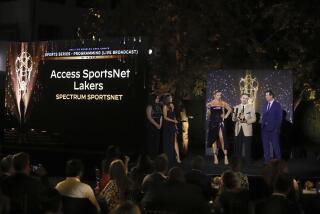Scratching a Niche
- Share via
Food. Animals. Games. Great sports moments of the past.
Such topics certainly seem worthy of a television special, perhaps even a weekly series.
But is anybody really asking for 24-hour, seven-day-a-week networks dedicated to such matters?
Welcome to the world of cable television, where any endeavor--no matter how narrowly targeted--now seems to be a candidate for its own channel.
Weekend hackers no longer need wait until Saturday to watch Tiger Woods play or to work on their swings: The Golf Channel is available round the clock. Those who hanker for more literal woods, meanwhile, can catch the latest in hunting and fishing on the Outdoor Channel or the Outdoor Life Network.
As television listings expand until the grids from weekend TV guides begin to resemble the phone book, some obvious questions arise: Namely, where do these channels get programming? How do they survive? And, for that matter, is anybody watching?
Some observers have likened the explosion of cable options to other niche-oriented media, such as radio and magazines. There is, however, a key difference: While a radio station can hire a talk host or disc jockey and start making money, in television someone has to produce or acquire TV programs appropriate for concepts like Home & Garden Television, the Travel Channel and Nostalgia Television--a much more expensive proposition.
Fledgling cable channels must balance their need for programming against revenue limitations. Many focus on programs that cost relatively little to produce, interspersing them with repeats they can creatively repackage, as Nickelodeon has done with its nighttime lineup.
And cable networks do have an advantage over broadcast outlets in having two revenue streams, receiving per-subscriber payments from cable operators in addition to the advertising they sell.
Yet the challenges facing new channels are formidable. Despite technological advances that have expanded channel capacity, the number of new services far surpasses the ability to accommodate them. According to the National Cable Television Assn., more than 110 cable networks are available, while the average cable system currently offers 53 channels.
Many of those slots are set aside for the major networks and other over-the-air stations that operators are obligated to carry. Moreover, virtually all systems offer CNN, ESPN, Nickelodeon, TNT, USA and MTV--leaving less-established channels to jockey for space.
Without that cable real estate, new networks have trouble achieving the critical mass necessary to attract national advertisers. Generally, the magic number is exposure in at least 20 million homes, but some sponsors require 30 million or 40 million before they’ll buy commercial time.
Those ads don’t exactly command “Seinfeld” dollars either, given that ratings formost new channels amount to a puny fraction of the 97 million homes with television in the United States (about two-thirds of which receive cable). Small wonder that many of the new services are losing money, with the odds of success thus favoring companies with pockets deep enough to pursue long-term business plans.
“It’s going to be tough for an entity with a very narrow subject to have the same kind of success networks that launched in the late ‘70s and early ‘80s have,” says Michael J. Eckert, chief executive of the Weather Channel, which has been around since 1982 (see related story, Page 65).
Such services nevertheless continue to nibble away at the viewing pie, swiping viewers from the major networks--whose ratings have fallen to historic lows--as well as better-established cable channels, where viewership has flattened out.
Seeking to provide a better glimpse into this confounding and crowded universe frequently lumped together simply as “cable,” Calendar took a look at a diverse quartet of relatively new services: the Food Network, Animal Planet, Classic Sports Network and the Game Show Network.
At present, each of these channels reaches no more than 1 in 4 American households. Their audiences are measured by the thousands, compared to the 11 million people who tune in Fox--the least-watched major network--on an average night. Still, each has its own strategy for standing out on the magazine rack that is your cable box:
THE FOOD NETWORK
Headquarters: New York.
Launched: November 1993.
Current reach: 25 million homes.
Promotional slogan: “We’re Really Cooking.”
Average viewership: 50,000 to 200,000 homes.
Programming: “Gourmet Getaways With Robin Leach,” “Chef du Jour,” “Too Hot Tamales,” “The Dessert Show.”
*
The Food Network proudly boasts that 95% of its programming is original, as opposed to the reliance on repeats by many cable programmers.
“We are one of the most active television studios in the United States,” said President Erica Gruen. “All our programs are homemade.”
Because the channel is privately held, Gruen wouldn’t discuss how much the network spends on production or whether the venture is profitable. The programming, she acknowledges, “doesn’t cost as much as producing ‘ER.’ ”
Food’s main point in marketing itself to cable systems lies in its ability to attract new advertisers, especially local supermarkets and food stores that might not otherwise buy time on cable. Gruen says the network reaches more than 1 million viewers during the course of a week, though considerably fewer tune in during an average half-hour, with men accounting for nearly half the prime-time audience.
One of the most popular programs is “Emeril Live,” and the channel sees its host--master chef Emeril Lagasse, who has a second show on the network titled “Essence of Emeril”--as a personality who might become to the Food Network what Howard Stern is to E! Entertainment Television.
“Every cable network has [to have] that defining show,” Gruen says. “Without it you can’t get anywhere.”
Toward that end, the Food Network uses a farm system (that’s a baseball, not a food, analogy) to identify and train potential talent. The channel features shows that allow various chefs to strut their stuff on a trial basis, including “Ready . . . Set . . . Cook!” and “Chef du Jour.” Some of the network’s “stars” have been discovered that way, including Lagasse.
The Food Network doesn’t spend much on advertising but received plenty of free publicity in January when a pornographic video inexplicably appeared on the channel for a few minutes while two chefs on the show “Too Hot Tamales”--Susan Feniger and Mary Sue Milliken, owners of the Border Grill restaurant in Santa Monica--described how to make risotto.
Gruen calls the incident “very upsetting” and says the network still hasn’t ascertained how it happened. Reporters, meanwhile, had a metaphorical field day.
“There’s something about sex and food that goes together,” she says. “The double-entendres in those articles were shameless.”
ANIMAL PLANET
Headquarters: Bethesda, Md.
Launched: June 1996.
Current reach: 22 million homes.
Promotional slogan: “All Animals. All the Time.”
Average viewership: 40,000 to 90,000 homes.
Programming: “Lassie,” “Flipper,” “Crocodile Hunter,” “Emergency Vets,” “Once Upon a Tree.”
*
Thanks to its co-parentage with the Discovery Channel--which is partially owned by an affiliate of Tele-Communications Inc., the nation’s largest cable operator--Animal Planet achieved one of the fastest launches in recent cable history.
Still, executives say the format--ranging from nature documentaries and children’s programming to “The Pet Shop,” a prime-time show featuring celebrities and their pets--must sink or swim on its own.
“At the end of the day, people only launch services if they think they’re going to add value over time,” says Clark Bunting, senior vice president and general manager.
By the end of this year, two-thirds of the network’s programming will be either original or new to the United States, such as nature programs produced abroad. While “The Pet Shop,” hosted by comic Andy Kindler, wouldn’t be traditional Discovery Channel fare, Bunting says the unifying theme to the network’s eclectic lineup is to “tap into the almost primal connection that people have with animals.”
Bunting adds that the rather novel name “tells people what the editorial promise of the network is,” adding that there is “not a lot of brand fuzziness” with Animal Planet, unlike some of the other new cable channels.
A big part of the overall lineup is geared toward children, including “Once Upon a Tree,” an original show featuring animal puppets and music, and “Jim Henson’s Animal Show.” The three-hour kids’ block runs twice between 6 a.m. and noon.
The network also offers both old and new episodes of “Lassie,” which Bunting calls “a cultural icon of family programming.” The original installments are shot in Canada, so the network gets a break on the production costs: Not only does it cost less to produce programs there, but rights to the series have also been sold overseas, footing part of the bill.
Bunting won’t discuss the network’s financial status but concedes that the network must keep adding cable systems to establish its viability for many national advertisers. In the meantime, he insists Animal Planet is buying and producing programs as aggressively as any national network.
“You have to look like a mature service today right out of the blocks. No one says, ‘They’re a year-old service, let’s cut them slack.’ If they don’t like it,” Bunting says, “click, they’re gone.”
CLASSIC SPORTS NETWORK
Headquarters: New York.
Launched: May 1995.
Current reach: 10 million homes.
Promotional slogan: “Where the Legends Play.”
Average viewership: unknown.
Programming: “Tonight at the Fights,” “Classic Sports Legends,” “Distant Replay.”
*
Co-founder and Chief Executive Brian Bedol says Classic Sports conducted focus groups with fans before its launch, and about half of the subjects asked why they’d want to watch old games in which they knew the outcome.
“Once we started running tape, everyone was glued,” he recalls. “That was when we knew we were onto something.”
Despite losing an undisclosed amount of money at this point, privately held Classic Sports appears to have found a bankable niche and is considered a prime acquisition target. Potential buyers include Fox, which sees the channel as a complement to its regional sports networks. (The service even bills itself as being “the ultimate place for sports fans to hang out between games.”)
In addition to repeating games in their entirety (you could see Magic Johnson and the Lakers win a championship or Michael Jordan during his collegiate days) via library deals with all the major sports leagues and the National Collegiate Athletic Assn., the network assembles programs and theme weeks highlighting sports greats.
“We look at our library as being these incredible ingredients to create programming, but they’re also great as they are raw,” Bedol says.
Classic Sports has assembled an advisory “board of champions” featuring noted sports figures such as Ernie Banks, Gale Sayers, Wilt Chamberlain and Ted Williams. Such personalities have also been incorporated into the programming, with Joe Namath and veteran announcer Tom Brookshier hosting “NFL Night at the Classics.” The network even dusted off a local New York interview show that Namath--then quarterbacking the Jets--hosted with Dick Schaap in 1969.
New shows maintain the nostalgia theme, such as “Distant Replay,” which brings in former stars to discuss their careers; or “Legend to Legend,” which introduces a current athlete to a star of the past. Classic Sports will spend about $10 million this year on original production, preferring to put its resources into programming rather than advertising. Indeed, the network has left its promotion largely to the nostalgic impulses of sportswriters.
“We knew going in that we were presenting material that by its very nature sportswriters were going to love,” Bedol says. “Two-thirds of what’s been written about us has just shown up in our press clippings.”
Beyond anecdotal evidence (some viewers write in to request specific games), the network can’t be sure exactly who’s watching. Nielsen Media Research doesn’t register networks nationally until they are available in at least 17 million homes--a threshold Classic Sports expects to cross within the next 12 months.
The network claims to provide high satisfaction to those consumers who receive it--perhaps the strongest asset a fledgling channel can offer cable operators.
“It’s forced us to be really good at our business,” Bedol says of the gradual roll-out. “All we have to go by is the quality of our product and the quality of our marketing.”
THE GAME SHOW NETWORK
Headquarters: Culver City.
Launched: December 1994.
Current reach: 8 million homes.
Promotional slogan: “All games, all the time.”
Average viewership: unknown.
Programming: “Trivia Track,” “Super Decades,” reruns of “Match Game,” “The Price Is Right,” “Family Feud.”
*
Even backed by a deep-pocketed corporate parent like Sony, the Game Show Network has had to take its time reaching the public. Network President Michael K. Fleming says distribution will exceed 10 million homes by 1998 and approach 20 million next summer.
Initially the channel has drawn heavily from a library of more than 50,000 game show episodes, many owned by Sony as the distributor of such long-running programs as “Wheel of Fortune,” “Jeopardy!” and “The Newlywed Game.” Mining those vaults gives value to old repeats that would otherwise collect dust--a major reason the channel was formed in the first place.
The Game Show Network nevertheless carries several original programs and plans to morethan double its output later this year, with new shows to account for roughly one-third of its schedule. As one of the most inexpensive TV formats, in fact, game shows seem particularly conducive to not putting too much financial stress on a start-up operation.
Game shows traditionally played to an older audience, principally made up of women who were available to watch during the daytime. While that image runs counter to television’s obsession with youth, Fleming says such shows provide an obvious vehicle through which certain advertisers can reach their target consumers.
“If you’re Procter & Gamble, then a service like Game Show Network has a lot more value to you prospectively than MTV does,” he says. “Who watching MTV is worrying about running out and buying a certain toothpaste?”
The network still wants to attract a wide range of viewers, however, and MTV helped demonstrate that game shows can appeal to a hip young crowd with its own take on the genre, including such series as “Remote Control” and “Singled Out.”
In similar fashion, Game Show Network is courting diverse age groups with upcoming programs that include “JEP!” (a teenage “Jeopardy!”) and “Wheel 2000,” a children’s version of “Wheel of Fortune” that CBS will also broadcast on Saturday mornings. Other original shows feature interactive elements: On “Super Decade,” contestants compete for prizes from home, punching in answers on push-button phones.
The network doesn’t foresee being profitable for at least two more years and is working under a long-term plan toward recouping its investment. Even so, the channel offers certain immediate benefits to Sony, which can use the little-seen network as a lab to develop shows that might later be sold to broadcast outlets as well as a model for channels the studio plans to introduce overseas.
Fleming says he has no illusions about Game Show Network rivaling NBC’s “Must-See TV” but wants to become one of the options to which some of the audience will turn.
“I don’t expect to be the [viewer’s] first choice,” he says. “I want to be the sixth place or the seventh place you go to. . . . I want to be a destination.”
More to Read
The biggest entertainment stories
Get our big stories about Hollywood, film, television, music, arts, culture and more right in your inbox as soon as they publish.
You may occasionally receive promotional content from the Los Angeles Times.










